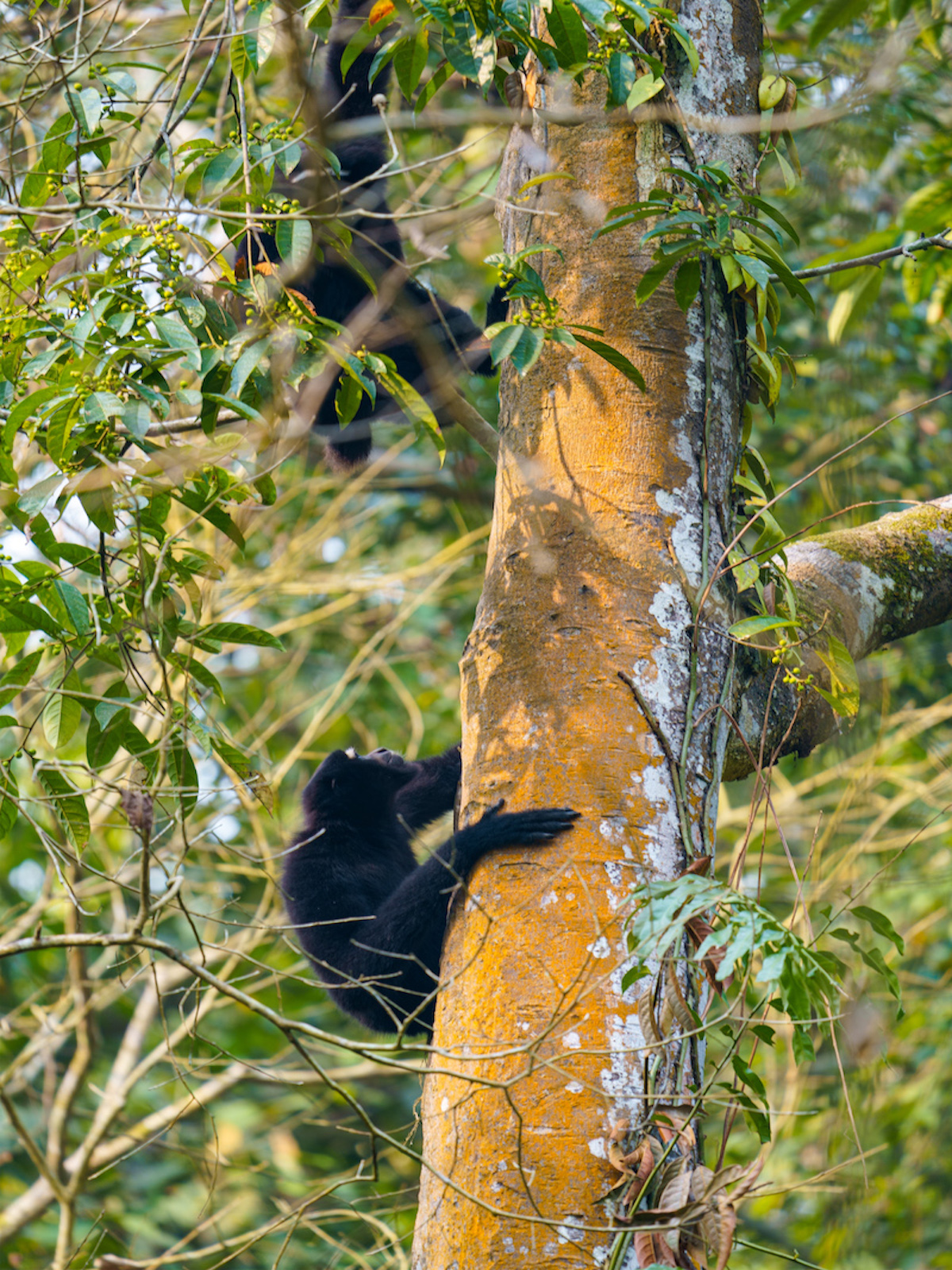Planning a trip to Kaziranga and looking for things to do other than the jeep safaris? If the answer is yes, then head to Hoollongapar Gibbon Sanctuary a two hour drive from the Land of the Big 5. The Sanctuary gets it’s name from the native Hoollong tree and it’s flagship species – Hoolock Gibbon (India’s only ape species). While the Sanctuary is relatively small (20 odd square KM) and is surrounded by tea gardens and villages, it is still home to not just India’s only ape but also six other species of primates and other wildlife. Visit our Instagram page to see more photos of Gibbons and other wildlife.

Arboreal – lives on trees
The other primates that inhabit this small patch of dense forest are the Capped Langur, Pig-tailed Macaque, Stump-tailed Macaque, Assamese Macaque, Rhesus Macaque and the Slender Loris (nocturnal). Leopards and Elephants are also known to visit the sanctuary.
The Hoolock Gibbon is an arboreal animal which means that it barely steps on to the forest floor. Gibbons move from tree to tree with the help of their incredibly long arms (this movement is also known as brachiation) feeding on fruits and sleeping in the upper canopy. With the huge demand for tea and subsequent felling of forests, the Gibbon’s habitat has significantly reduced since the 1900s and their populations have dwindled in the North East significantly.

Hoolock Gibbon mother and baby

Male Hoolock Gibbon
Today, gibbon families are separated from each other limiting co-mingling with other families thereby preventing a diverse gene pool. This gene pool diversification and protection of it’s habitat is critical if we want the Hoolock Gibbons and other endangered primates to survive and grow in the long term.
Even when I visited the Sanctuary recently, I was surprised to see the Sanctuary cut in two by an active railway track. The passing train showed no signs of slowing down and made it’s presence loud and clear, clearly making the area around the tracks extremely hazardous for wildlife. I wondered how often these animals crossed over to the other side of the train tacks with an absence of man-made or natural bridges?

Passing train in the Gibbon Sanctuary

Amazed to see the Apes
To see the wildlife, you must arrive at the Sanctuary by dawn. The Sanctuary is closer from Jorhat (a 30 minute drive) than it is from Kaziranga. If you want to visit more than once then it is recommended to stay in Jorhat. At the time of purchasing tickets you have the option to walk (this is a walking safari, no vehicles are allowed inside) in the Sanctuary for half a day or the full day (sunrise to sunset). The primates (and bird life) in the Sanctuary are mostly active from dusk till about 9AM.
If you happen to be there just before or after the monsoons, it is recommended to wear gum boots and leech socks. Even in the month of March when it was almost 35 degrees I saw a couple of leeches wrangling their way up my shoe. The worry of my precious blood being sucked by leeches was distant in my mind when within ten minutes of starting the walk I saw a family of five gibbons including a very curious looking new born who was still clutching on to it’s mother.

Hoolock Gibbon baby

Red-headed Trogon
Male Gibbons are black where as females are buff or brown in color. Other than the Gibbons I saw the Capped Langur. Unfortunately, no signs of the other primates during my three hour walk. I wasn’t disappointed though as I saw a Red-headed Trogon which is considered a very elusive species.
A guide and a forest guard are mandatory and will accompany you on your trek inside the Sanctuary. You will need to organize a taxi as there is no reliable public transportation to / from the Sanctuary. There are also no major tourist facilities in or near the Sanctuary so carry water, food, cash (no machines or ATMs) etc. You can eat breakfast once you are back from your trek. No food is allowed inside the Sanctuary as that attracts a lot of un-wanted attention and NO, you may not feed these ‘monkeys’ as you may have done in your neighbourhood park. A half day visit to the Hoollongapar Gibbon Sanctuary is well worth the effort if you are planning to stay in Kaziranga for a few days.

Happy faces after spotting the Gibbons



